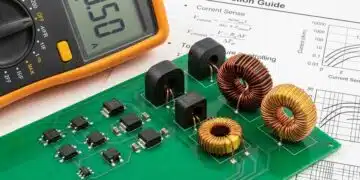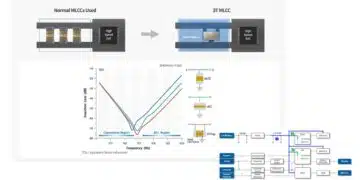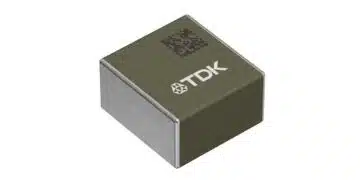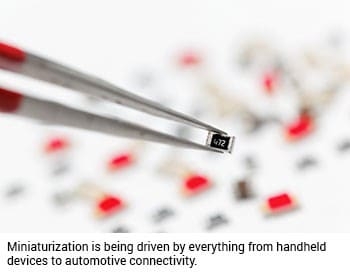source: TTI article
Mike Wood, TTI
Given that passive components make up the greatest percentage of the physical space on the circuit board, it’s no surprise that miniaturization is the dominant trend in passive technologies. Increasingly, chip manufacturers require smaller package designs that deliver the same capacitance or resistance as their former larger versions. Passives manufacturers are complying with this demand by offering extended value ranges in smaller package designs. For example, buyers can now source multilayer ceramic capacitors (MLCC) with specs of 2.2uF capacitance and a 10 volts rating in the smaller 0201 package size versus the formerly common 0402 size.
The miniaturization trend is being driven by everything from handheld devices to automotive connectivity and many other Internet of Things (IoT) applications. According to Gartner, 6.4 billion connected things will be in use by the end of the year. And, that number is predicted to increase to 20.8 billion by 2020. Impressively, a whopping 5.5 million new things get connected each day and the consumer market is definitely leading that pack. With the growth of IoT and connected devices, TTI expects passive demand to increase marginally during the second half of 2016.
Part of the IoT revolution, automotive – both fossil fuel and electric vehicles – continues to be a significant growth sector for passives. Though the overall automotive market remains flat, the electronicization of the automotive sector is rapidly growing – up to six percent each year. It is expected that electronics will make up approximately 50 percent of product costs of vehicles by 2030.
In addition to miniaturization, passive components increasingly need to perform in harsher environments, with specifications for extreme temperatures, vibration ratings, dust and liquid resistance, etc. High-temperature capacitor technology is a growing trend, especially for ruggedized components that can withstand temperatures exceeding 200°C (392°F). Primary applications for this technology include automotive, aerospace and oil and gas.
Medical is another opportunity segment for passi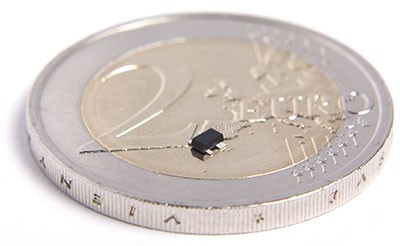 ves and consumer behavior is driving the majority of this growth, as individuals strive to better understand and measure their health. As a result, wearable medical technology and devices that are “invisible” to the individual are inundating the market. Because size efficiency is critical, MLCCs are an ideal candidate for using the most powerful passive components with the smallest footprint. As more Class I and Class II devices, such as vital sign monitors, cholesterol meters, glucose meters and insulin pumps are developed and are approved by the FDA, the demand for both passive and active components will increase in this space. In addition to these wearable devices, the medical industry is increasingly looking to create smaller, more efficient and compact packages for technologies than can be used for things like medication delivery.
ves and consumer behavior is driving the majority of this growth, as individuals strive to better understand and measure their health. As a result, wearable medical technology and devices that are “invisible” to the individual are inundating the market. Because size efficiency is critical, MLCCs are an ideal candidate for using the most powerful passive components with the smallest footprint. As more Class I and Class II devices, such as vital sign monitors, cholesterol meters, glucose meters and insulin pumps are developed and are approved by the FDA, the demand for both passive and active components will increase in this space. In addition to these wearable devices, the medical industry is increasingly looking to create smaller, more efficient and compact packages for technologies than can be used for things like medication delivery.
The pricing environment for passives remains very competitive on resistor, ceramic and tantalum chips. Established reliability and non-commodity passives are likely to see firm pricing or a temperate increase year-over-year for the foreseeable future. The exception to this flat forecast is in the high capacitance ceramic chips. Ceramics offer unsurpassed volumetric efficiency by delivering the highest capacitance in the smallest package design. Expanded ceramics demand, attributable to growth in the Asia Pacific region and the global automotive market, is tightening supply, which could drive increased pricing.
Lead times in the passive market tend to be aligned with pricing conditions, so they are stable for the majority of the market. Again, the exception is in the ceramic chip market, where demand is currently outpacing new capacity. Lead times are likely to increase on average four to six weeks depending on the value and case size.
Distribution remains a key sourcing strategy for manufacturers since the distribution model offers greater stability in availability and lead times. Supply chain solutions such as the TTI Advanced Inventory Management (AIM) program give manufacturers an edge in managing market volatility risks. By proactively engaging with clients on their supply chain strategies, distribution partners like TTI offer manufacturers greater stability and reduce non value-added transaction.
The authorized distribution channel is also increasingly important to buyers during shortage periods where availability decreases and counterfeit components tend to show up more frequently. Authorized distributors extend all factory warranties, while the non-authorized (broker) channel cannot. As a result, it’s not a surprise that nearly every occurrence of counterfeiting can be attributed to the unauthorized conduit.
In summary, the market for capacitors and resistors is balanced overall. However, global markets and economies can quickly have an impact on this environment and manufacturers should always be looking to the trends that will affect their ability to compete in the future. So, buyers should look for a distribution partner that believes in inventory, keeps their sights fixed closely on the market and can quickly identify potential changes in supply to keep your supply chain running in model condition.
A version of this article appeared in Electronics Sourcing North America, September 2016, www.electronics-sourcing.com/north-America.







